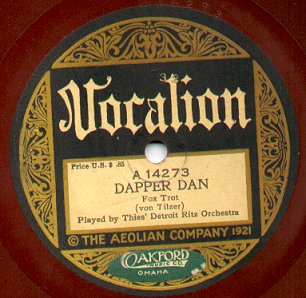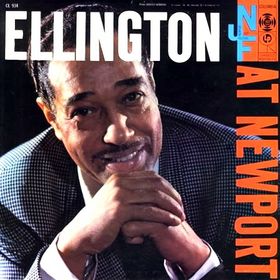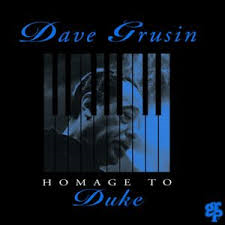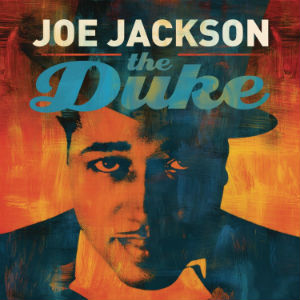
Albany Leon "Barney" Bigard was an American jazz clarinetist known for his 15-year tenure with Duke Ellington. He also played tenor saxophone.
James Wesley "Bubber" Miley was an American early jazz trumpet and cornet player, specializing in the use of the plunger mute.

Joe "Tricky Sam" Nanton was an American trombonist with the Duke Ellington Orchestra.

For Decca's Vocalion label, see Disques Vogue

Albert George "Al" Hibbler was an American baritone vocalist, who sang with Duke Ellington's orchestra before having several pop hits as a solo artist. Some of Hibbler's singing is classified as rhythm and blues, but he is best seen as a bridge between R&B and traditional pop music. According to one authority, "Hibbler cannot be regarded as a jazz singer but as an exceptionally good interpreter of twentieth-century popular songs who happened to work with some of the best jazz musicians of the time."

Ella and Duke at the Cote D'Azur is a 1967 live album by Ella Fitzgerald, accompanied by the big band of Duke Ellington.

Ellington at Newport is a 1956 live jazz album by Duke Ellington and his band of their 1956 concert at the Newport Jazz Festival, a concert which revitalized Ellington's flagging career. Jazz promoter George Wein describes the 1956 concert as "the greatest performance of [Ellington's] career... It stood for everything that jazz had been and could be.". It is included in the book 1001 Albums You Must Hear Before You Die, which ranks it "one of the most famous... in jazz history". The original release partly recreated in the studio after the Ellington Orchestra's festival appearance.
This is the discography of Duke Ellington. Most of these recordings are listed by the year they were recorded rather than year released. Reissues are listed for most of the recordings released before the 1950s, as the original 78s are rare. The US chart listing information should be considered tentative because sources like the Joel Whitburn's Pop Memories does not take the cheaper dime-store records into account. During this period, records sold by song title, not by artist, although there are exceptions.
"Among My Souvenirs" is a 1927 song with words by Edgar Leslie and music by Horatio Nicholls.

The Popular Duke Ellington is a studio album by American pianist, composer and bandleader Duke Ellington featuring many of the tunes associated with his orchestra rerecorded in 1966 and released on the RCA label in 1967.

The Great Summit: The Master Takes is a 2001 Blue Note album by Duke Ellington and Louis Armstrong. It's a reissue of the two Roulette albums Together For The First Time and The Great Reunion from 1961.

Live at the Blue Note is a live album by American pianist, composer and bandleader Duke Ellington recorded at The Blue Note nightclub in Chicago for the Roulette label in 1959.

Duke Ellington at Fargo, 1940 Live is a live album by the Duke Ellington Orchestra that won the Grammy Award for Best Large Jazz Ensemble Album in 1980. The album was recorded at a dance in Fargo, North Dakota.

The Smithsonian Collection of Classic Jazz is a six-LP box set released in 1973 by the Smithsonian Institution. Compiled by jazz essayist and historian Martin Williams, the album featured tracks from over a dozen record labels spanning several decades and genres of American jazz, from ragtime and big band to post-bop and free jazz. The compilation has been recognized as an invaluable document of jazz history and maintains a legacy as introductory listening for new jazz fans as well as scholarship due to its extensive liner notes.

Homage to Duke is an album by American pianist Dave Grusin released in 1993, recorded for GRP Records, and is Grusin's interpretation of Duke Ellington's music.

Star Dust is an album of phonograph records by Bing Crosby released in 1940 featuring songs that are sung sentimentally, being based upon the 1927 popular song "Star Dust". This album featured his 1939 Decca recording of the song, not the 1931 recording he made for Brunswick.

The Duke is the seventeenth studio album by English musician Joe Jackson. The album was released on 26 June 2012 by Razor & Tie Recordings.

Harlem Jazz, 1930 is a compilation album of phonograph records assembled by Brunswick Records during the American Federation of Musicians strike, cataloguing the effect of the Harlem Renaissance on what was known as Dixieland, or "hot" jazz in New York City. The album features venues the orchestras played at the time of the recordings, such as Connie's Inn or The Cotton Club.

Ellingtonia, Vol. Two is a compilation album of phonograph records assembled by Brunswick Records during the American Federation of Musicians strike, cataloguing the famed early recordings of Duke Ellington on Brunswick and Vocalion Records. During the later Swing era, the recordings were praised for accurately predicting the developments in the Big band genre several years in advance.























